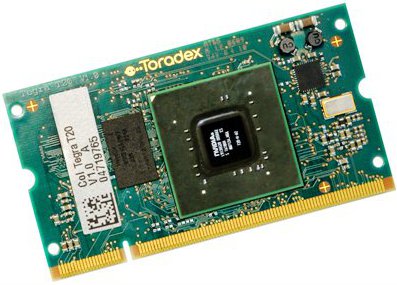Module family pumps up with dual-core Tegra 2
Jul 20, 2010 — by Eric Brown — from the LinuxDevices Archive — 10 viewsToradex announced a new member of its Colibri module family based on the Nvidia Tegra T20 system-on-chip (SoC), whose dual ARM Cortex-A9 cores are clocked at 1GHz. The Colibri Tegra T20 ships with 256MB of DDR RAM and 1GB flash, supports 1080p video playback, and offers interfaces including Ethernet, USB, I2C, and SPI, says the company.
The Colibri Tegra T20 is the latest — and by far the most powerful — of a series of Linux-compatible "Colibri" CPU modules. These have previously been based on Marvell PXA processors, such as the PXA320-based Colibri PXA320 module (see farther below for more on the Colibri line.) The Colibri Tegra T20 is said to be fully pin-compatible with the existing Colibri modules, allowing smooth migration of designs, says the company.

Colibri Tegra T20
Nvidia's Tegra T20 SoC incorporates eight independent processors, which may be "used together or independently to optimize power usage at all times," according to Nvidia. The CPU, clocked at its maximum 1GHz in the Toradex module, is a dual-core version of ARM's Cortex-A9. The SoC's low-power Graphics Processing Unit (GPU) is said to support 3D rendering capabilities for advanced graphics applications.
The Colibri Tegra T20 is equipped with 256MB of 32-bit DDR RAM, as well as 1GB of flash storage, says Toradex. The module supports 1080p video playback, with display resolutions up to 1920 × 1080 pixels, says the company.
LCD displays are said to be supported at up to 1680 x 1050 resolution. Unlike previous models, the Colibri Tegra T20 supports an HDMI interface.
The module supplies a 16-bit external bus, supports dual SD card slots, and offers 10/100Mbps Ethernet support and a high-speed USB Host/Device interface, says Toradex. Additional I/O is said to include I2C, SPI, IrDA, One-Wire, as well as three UARTs.
As with previous Colibri modules, the Tegra T20 version offers 4/5-wire touch interfaces, as well as camera interfaces, audio I/O, PWM, and GPIOs (up to 110 of them).
The 2.66 x 1.44 x 0.20-inch (67.6 × 36.7 × 5.2mm) SODIMM module can withstand temperatures from -4 to 158 deg. F (-20 to 70 deg. C), says Toradex. Power consumption is said to run at less than two Watts.
Colibri background
The last time we heard from Toradex was in September of last year when the company announced a revised, Linux-ready Limestone 2.0 design kit targeting creation of customer-specific PDAs, and featuring an 806MHz Marvell PXA320 processor.
The Limestone PDA kit was said to be an outgrowth of the company's Colibri computer modules, such as the Colibri PXA320, Colibri PXA290, and Colibri PXA270. Like the first Limestone kit, released in November of 2008, the Limestone doesn't actually employ the actual SODIMM modules. Instead, its 806MHz PXA320 processor and other features are integrated onto an available main board.
Availability
Samples of the Colibri Tegra T20 will be available for purchase and evaluation in the fourth quarter with a Windows BSP, says Toradex, which adds that Linux and QNX will be supported by third parties. More information and a link to a datasheet PDF may be found here.
This article was originally published on LinuxDevices.com and has been donated to the open source community by QuinStreet Inc. Please visit LinuxToday.com for up-to-date news and articles about Linux and open source.